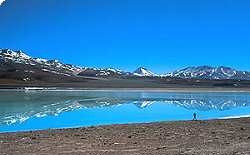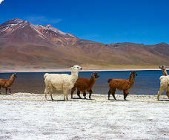Altiplanic Lagoons
- Share:
- Send Friend
- Tweet
Located at 90 kilometers from San Pedro. Miscanti and Miñique are located more than 4,000 meters above sea level. Both are fed by water sources that come from the surface of the land, attract a great variety of animals, like the abundance of flamingoes, a severe contrast surrounded by snowed mountains and shiningly reflected in its waters. The trip from San Pedro goes through Toconao and borders the Atacama Saltlake.
These Altiplanic lagoons are one of the 7 sectors that conform Los Flamencos (The Flamingoes) National Reserve. They are located at 18 kilometers to the south of Socaire. The landscape is characterized by volcanos and mountainous relief, standing out the hills Miscanti and Miñiques. In the lagoons inhabit species like: tagua cornuda, Chilean flamingo, parina chica, caitó, playero de baird, chorlo de la puna, juarjual duck and the guallata. The flora is composed mainly by the llareta and paja brava. In the bordering sectors archaeological sites exist.
Also we found the Laguna Verde (Green Lagoon); Mountain lagoon, is located to the 4,325 m.s.n.m., and 265 kilometers to the northeast of Copiapó. It is of an intense emerald green color, surrounded by Andean summits. Without apparent life, in its Southern shore outcrops of warm thermal waters take place, at only 21 kilometers from the limit and border with Argentina to the edges of the route to the Paso San Francisco.
The geological formations of the hills and adjacent lands allows to verify the successive volcanic contributions in the area, also represented by the near volcano Ojos del Salado, which last eruption dates from 1956.
Finally is necessary to name the Sejar Lagoon; a natural atmosphere of beauty, with turquoise waters, surrounded by crystals of salt of diverse forms. Its geomorphologic construction is a very peculiar case in the Atacama Desert; it is produced by the dissolution of caucasian structures.



 Now! With traveller reviews from
Now! With traveller reviews from 